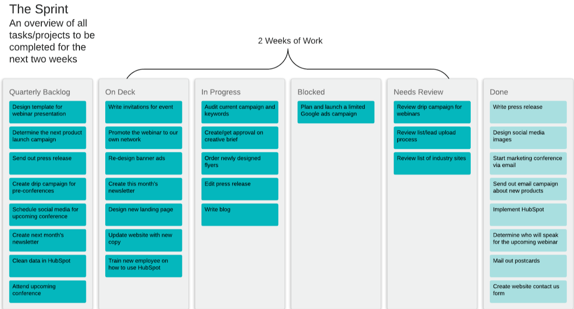Marketing isn’t something you do once - there’s no “set it and forget it.” In this business, you slide backwards when you’re not continuously improving. And with the growth rate of new tech, it’s no wonder. If you’re not consistently looking for new ways to improve your processes, you run the risk of stagnating and losing your agility.
So, how do marketers maximize their impact on a company’s goals? It all starts with culture; continuous improvement is something to be cultivated, and a culture that cultivates growth will never stagnate.
Just like your New Years’ resolutions, it’s challenging to implement a culture like that without momentum eventually stalling. It requires vigilance and discipline to achieve long-term growth, so we’ve put together a few marketing habits for continuous improvement.
1. Visualize your Value Stream
Are there processes in your organization that add value? If the answer is yes, then it’s well worth the effort to document exactly how you do it. (If the answer is no, then don’t worry about the rest of this article; you have much, much bigger problems.)
One of the most successful ways of documenting value is visualizing what we call a Value Stream. A Value Stream is a process for reducing wasted time/effort and gives you a step-by-step picture of your marketing processes. Each project goes through the steps of your Value Stream, and visualizing the process gives your team the opportunity to identify issues and navigate problems before they arise.
To give you an example, at 1 Bold Step we use Asana for project management. While it depends on the project, we generally use an Agile methodology to organize our tasks into 6 main buckets: Quarterly Backlog, On Deck, In Progress, Blocked, Needs Review, and Done. We can visualize how each task moves through the stream, which gives us a snapshot of the project’s current state and allows us to plan ahead for potential roadblocks.

This overview helps the 1 Bold Step team get a clear picture of exactly what needs to be done for any given project and helps us be proactive about process improvements.
2. Engage and Empower Your Team
Roadblocks to improvement look different to every organization, but one of the biggest factors is team engagement. Team members who are disengaged don’t feel empowered and lack ownership over their work. Sometimes it’s the individual’s responsibility, but leaders also need to be aware and avoid behaviors that discourage their team.
Behaviors like micromanagement, unconstructive feedback, and inconsistency can leave employees feeling stifled. Leaders should be guides, allowing their teams to solve their own problems and only stepping in when needed.
This includes listening to employees and helping them feel heard. Give your employees a safe environment to offer suggestions and give feedback so that you can gather ideas for improvement. Create a two-way conversation and avoid simply being a megaphone. For team cohesion, everyone has to feel like they’re part of the solution!
Celebrating success also helps team members feel engaged. Having something to look forward to for a job well done is a fantastic way to feel ownership over a particular project. We like to say, “People who weigh-in; buy-in.” Giving people the opportunity to speak and to be heard is key in getting their full support of the project. Even if it’s a simple acknowledgment, everyone enjoys recognition and that their input is appreciated.
3. Hone Your Process Metrics
It’s easy to get overwhelmed by your data. With every new system and technology, we’re presented with a flurry of new patterns, metrics, and analyses that need to be parsed through. According to chiefmartec.com, the number of solutions avoidable for data collection has been the fastest-growing category of marketing technology solutions, increasing 25.5% since 2019.
Image Source: chiefmartec.com
Analyzing and collecting data can be a major time sink if done incorrectly!
That’s why it’s critical to choose your KPIs carefully. Knowing what’s important and what’s working and what’s not working will give your entire organization clarity on what you need to do to achieve success. The last thing you want to do is waste time measuring stuff that doesn’t move the needle.
Alongside project metrics, however, a good marketing department needs to measure their processes. As a company that follows Agile principles, some of the process metrics we use are Lead Time, Cycle Time, and Throughput.
- Lead Time: The time it takes from commitment to delivery to the customer
- Cycle Time: The time from start of execution to delivery of the finished product
- Throughput: The raw amount of work accomplished in a given time period
4. Become Jacks-Of-All-Trades
Maybe not EVERY trade, but having team members who are trained across different functions has a dramatic effect on process agility. Familiarity with each part of the process and each task within helps team members recognize opportunities and roadblocks, setting them up for smooth project flow and flexibility if parameters suddenly change.
Cross-functional teams also don’t have to worry as much about bottlenecks. While each member certainly brings their own skills and unique talents to the team, having backups for each type of task ensures projects don’t get stuck when one member gets backlogged.
That’s why agile marketing agencies should encourage continuing education; Giving employees a chance to expand their knowledge and skill sets beyond what they’re already experienced with, decreases dependencies, and paves the way for teams to complete (and own) projects from start to finish.
5. Experiment (And Measure!)
Your processes are perfectly optimized… right? How do you know? Successful Agile teams are always testing new ideas and new techniques for process improvement. It’s okay to think your processes are great, but it’s better to know for sure.
Agile companies (1 Bold Step included) love using the PDCA experimentation framework - Plan, Do, Check, Act.
- Plan: Identify problem/opportunity, analyze, and hypothesize
- Do: Test the hypothesis in a clear timeframe
- Check: Measure the outcome and compare it to the hypothesis
- Act: Carry out a plan of action/inaction based on the results
At the end of the day, experimentation won’t do any good if you don’t measure and document your results! In the words of Adam Savage of Mythbusters fame…
Innovation requires experimentation, so don’t be afraid to try new things - just make sure to document your results.
Ready To Continue Improving?
Those are just some of the habits we employ at 1 Bold Step to help us with continuous improvement. We didn’t implement this culture overnight - it’s a slow process that requires vigilance and a long-term focus.
We’ve found that the results are more than worth the investment. These marketing habits for continuous improvement make us more agile and further streamline our processes, which in turn allows us to deliver maximum value to our clients. Continuously.



.png?width=700&name=content-3679757_640%20(1).png)

